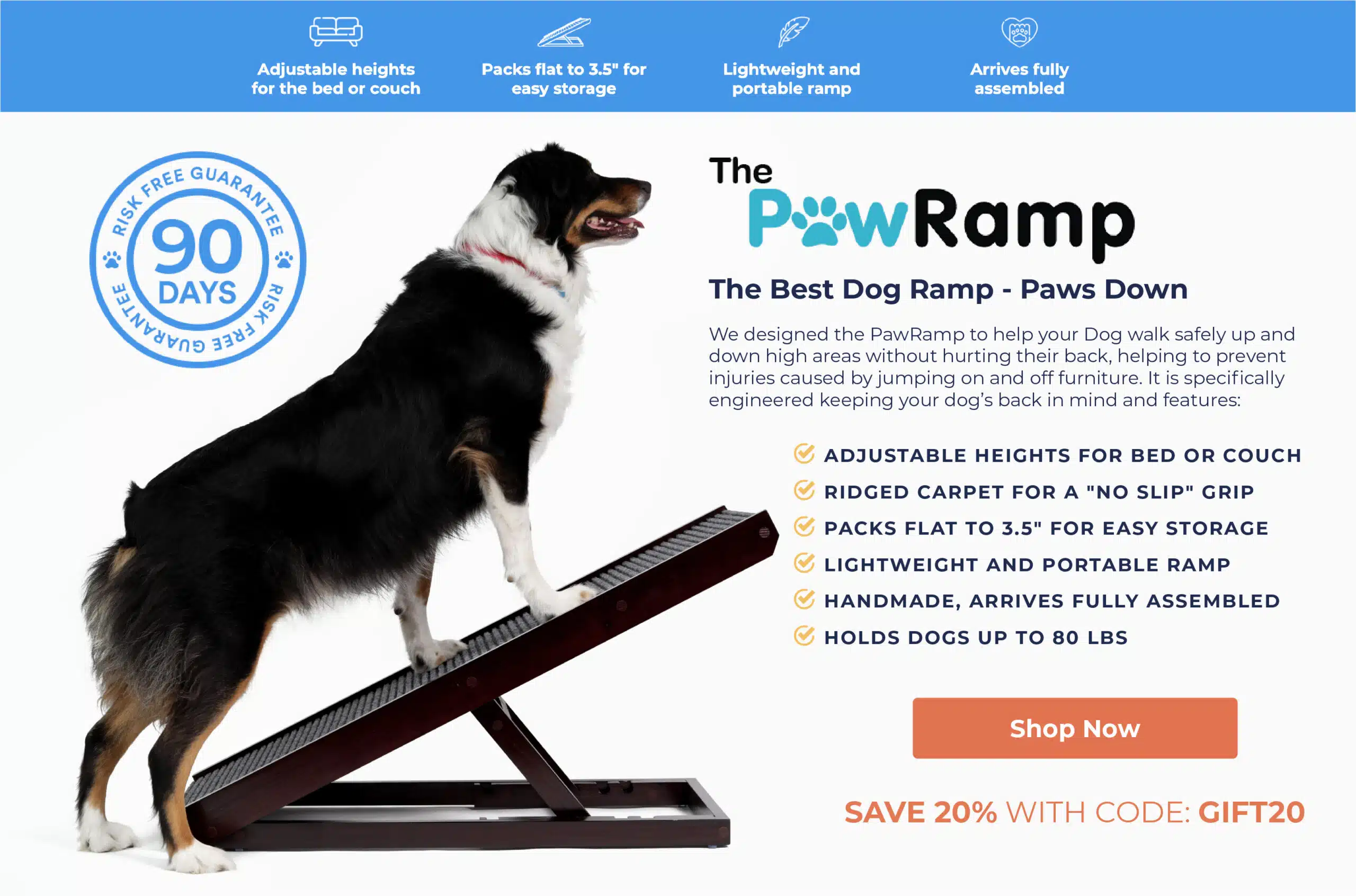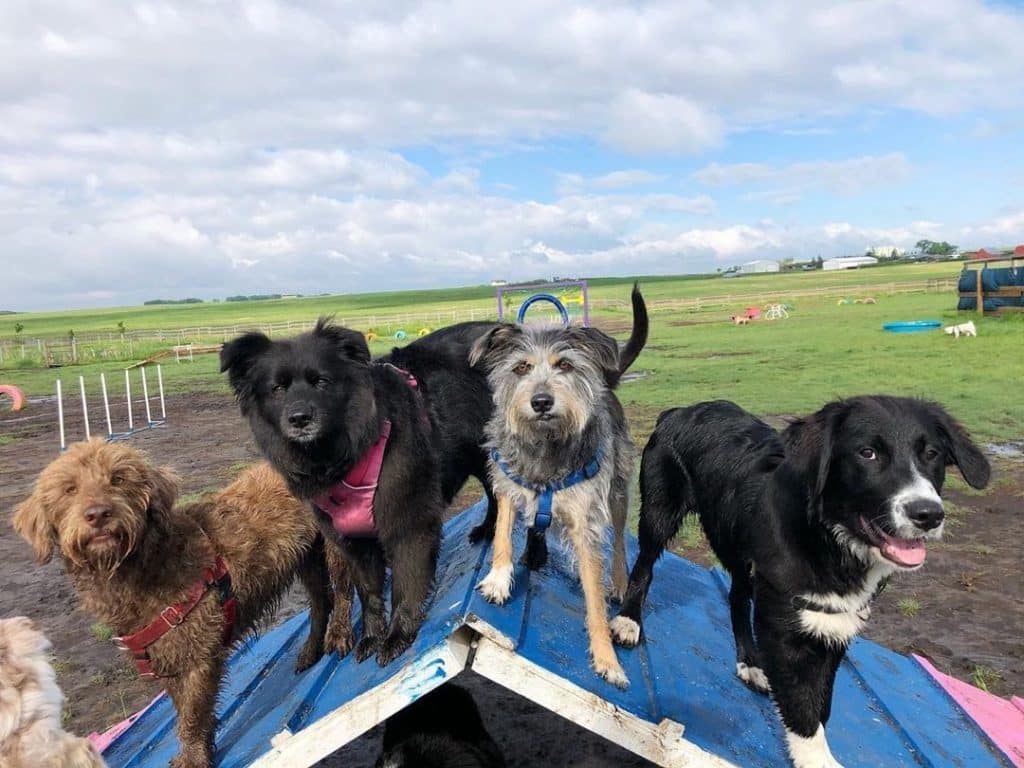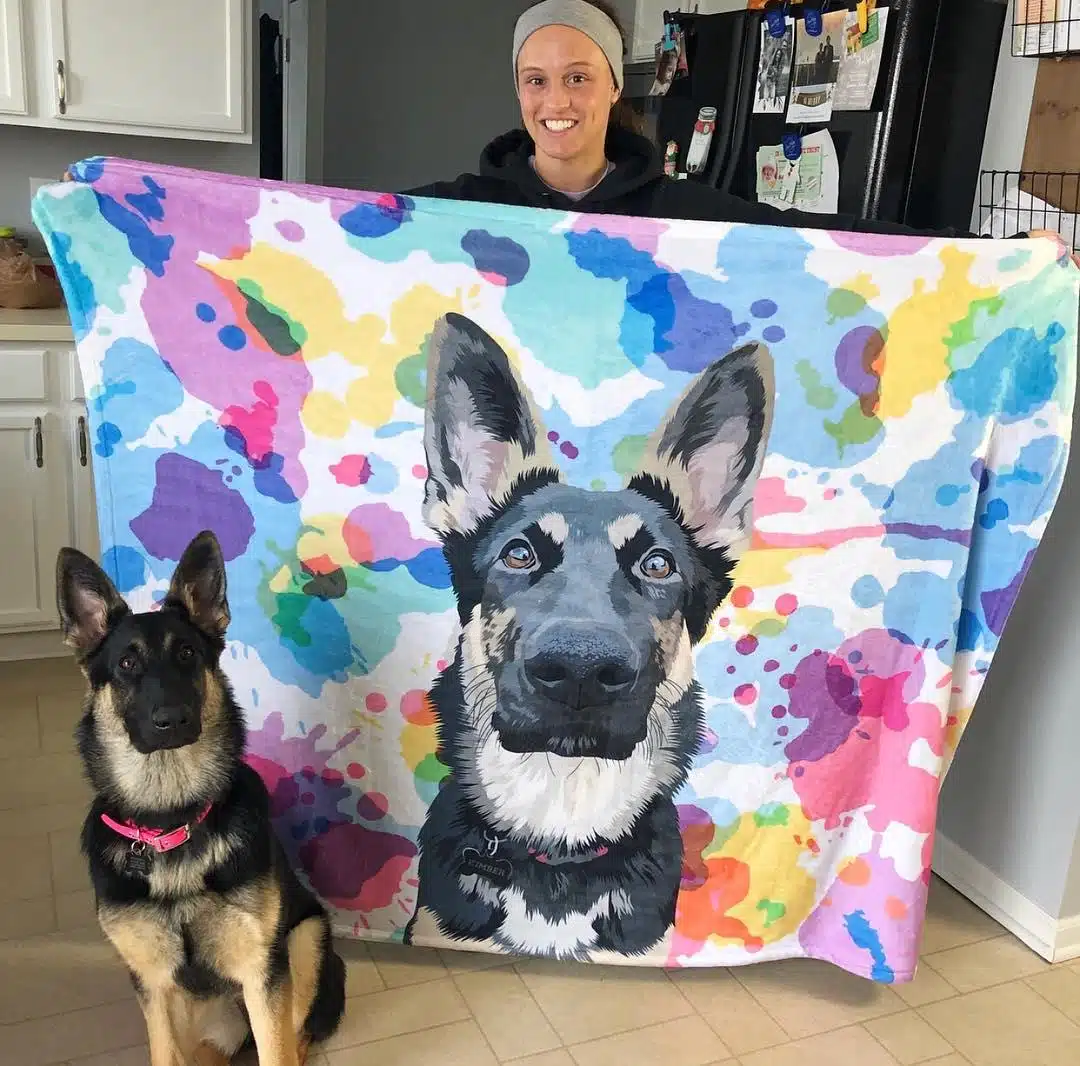Table of Contents
Dog Agility Ramp—All You Need to Know
Image source: yes_dog_airdrie
Are you interested in learning how to build an agility ramp for your dog? If you want to see your pooch having fun while exercising, get them an agility dog ramp. Not only will your little beastie have a good time, but you will also enjoy it.
Watch Dr. Ross’s Review on Dog Ramps
In this article, we are going to show you how to make an easy-to-assemble dog agility ramp and how to teach your dog to use it. You will also read some tips on how to protect your little one from getting injured. Let’s get down to business!
Consider This Before Getting Down To Work
When building a dog ramp, you need to put your dog’s safety first. Bear in mind that your fellow beastie will probably want to show off on the ramp once you train them how to use it. They will be demonstrating the top agility skills and move fast on the ramp—must keep the audience entertained, right?
The A-frame ramp needs to be stable and sturdy so that your pooch can use it without the danger of getting hurt. To build such a ramp, you need to take into consideration:
- Your canine’s size
- The ramp’s surface
- The ramp’s material
Your Canine’s Size
Your canine’s size determines how big the A-frame ramp should be. The ramp for bulky doggos, such as German Shepherds, needs to be wider than the one you build for smaller canines, for instance, Teacup Dachshunds or Chihuahuas. While your tiniest munchkins can use the ramp designed for their giant friends, it should never be vice versa.
In the table below, you can find our rough estimate of how wide the agility ramp should be.
| Dog’s Size | Ramp’s Width |
| Small dog | 35–40 inches |
| Medium dog | 40–45 inches |
| Large dog | 45–50 inches |
The ramp’s height and length depending on the stage of training your pup is in. You should start practicing with the ramp in a low position and raise it as they become more confident.
The Ramp’s Surface
Image source: agility_dog_daily
To make the agility ramp as stable as possible, you need to make sure that its surface is safe. If you have decided to build a wooden ramp, you will notice that wood is generally slippery. Dogs are not big fans of slides, and maybe your woofer suffers from acrophobia, you never know. Fortunately, we know some tricks that will help you make a walkway with a better grip.
The more sand you put in, the firmer grip your pooch will have. The non-skid walkway will provide your dog with confidence.
Another trick is to put crossbars across the ramp’s surface. Their length should be equivalent to the walkway’s width. The crossbars should be put at equal distances on both sides of the agility ramp. You can use lattice strips for these bars, but try to find the pre-painted ones, so that you minimize the work at home. They are a bit more expensive than regular ones, but the difference in price isn’t significant.
The Ramp’s Material
Dog ramps are most frequently made of:
- Plastic
- Metal
- Wood
But which material do you need to build a dog agility ramp?
Plastic ramps can’t be used as agility ramps as they are too unstable and slippery for your pooch. They can usually be used for smaller canines, but in this case, they will not provide them with stability, either.
Metal is also not a suitable material for dog agility ramps. They do provide great stability, but if you plan on training your dog outside, metal agility ramps are certainly not the best choice for you. They can get rusty fast if left out in the rain.
So, this leads us to the best solution—wooden ramps! You will find that the agility ramps are usually made of wood, and there’s a good reason for that. If primed and painted adequately, these ramps will be weather-resistant. They are suitable for dogs of all breeds, ages, and sizes.
The main disadvantage of wooden dog agility ramps is that they are heavy. You can always use plywood instead of solid wood, to make the ramp a bit lighter, but you should bear in mind that these ramps are larger than the regular ones and thus heavier.
Some dog parents have thought of attaching the wheels on the bottom and fixing them while training the dog, in case they plan on moving the ramp from time to time. We don’t disapprove of this method, but we do consider that constructing such a dog agility ramp should be done in consultation with agility trainers.
As we have mentioned before, wooden surfaces are slippery, so make sure you add sand grains and crossbars for a better grip. Below, you will see our suggestions on how to make a stable DIY dog agility ramp.
How to Make a Dog Agility Ramp
Image source: lifeoflola_cavapoo
If you need suggestions on how to make an A-frame for your backyard agility course—you’ve come to the right place.
Before you put your Bob the Builder cap on, make sure you have prepared all items you need for this little project. Here’s what you need:
- Saw
- Drill
- Hinges
- Screws
- Plywood (two boards)
- Lattice strips (four on each side)
- Sand
- Two buckets of paint
- Pen
- Chain
Now that you have everything you need—let’s start ramping! To make an A-frame dog agility ramp, we will divide our work into several stages:
- Measuring
- Cutting
- Sanding and priming
- Attaching the lattice strips
- Painting
- Joining the boards
Measuring
Before cutting, you need to measure and mark the plywood. By this point, you should have prepared the ramp’s dimensions. Use your pen to draw the cutting lines with precision. You need to build two slopes for an A-ramp, so make sure that both plywood boards are equal.
Cutting
Cutting the plywood is easy if you have marked all dimensions properly. Use a saw to prepare two thick plywood sheets and eight crossbars. We advise you to use gloves during this process to protect your hands. Goggles can also be useful as they can prevent the dust from entering your eyes.
Sanding and Priming
Bare wood and lattice strips should always be sanded and primed before painting. First, use sandpaper to smooth the entire surface. After that, use the primer to cover the plywood. Priming is important because it prevents the paint from sinking in right away and going patchy.
IVDD Survivor Story – Hannah & Louis
If you decide to paint the ramp without sanding or priming, it will look good at the beginning, but after some time, you will notice that the paint is starting to flake.
Try to find a mold and mildew resistant primer. We recommend two coats of primer for extra protection.
Attaching the Crossboards
Lattice strips should be attached to the ramp’s surface at equal distance. Both boards should have four of these crossbars. Use the drill and screws to attach them to the board.
You will see lots of agility ramps without this addition, but we consider it highly useful. Not only will the crossbars make your fellow more confident on the walkaway, but it will also protect them from sliding off of it.
Painting
Consider painting each side of the A-frame with two distinct and vivid colors. The purpose of this is to help your pooch get a clear picture of the obstacle. We recommend you to use contrasting, eye-catching colors, such as yellow and blue.
You should paint the crossbars based on the color of the board. So if the part of the ramp where you attach the lattice is blue, that means that the lattice should be of the same color.
Joining the Boards
It’s high time we made that letter A. Take your screws and hinges and connect the boards at the top. Make sure to attach them firmly so that the ramp is stable. On each side of the ramp’s interior attach eye-rings midway down. Pull the chain through the rings to enable adjusting the ramp’s height.

Why Is Dog Agility So Popular?
Image source: blue_dog_and_me
Agility is a sport where a handler needs to guide the dog through an obstacle course as fast and as accurately as possible. The popularity of this sport is on the rise in the United States, and lots of dog owners opt for it because it combines two useful things—exercising and spending time with your precious canine.
Agility is a rewarding sport for both you and your pooch. While you train your dog for speed and accuracy, many things are happening that you are not even aware of. Agility exercises are valuable as they:
- Create a stronger bond between the owner and the pooch
- Provide with mental stimulation
- Improve the dog’s ability and stamina
- Satisfy your canine’s instincts
How to Train Your Dog to Use the A-Frame Dog Agility Ramp
Image source: a_springer_called_charlie
When you decide to train your dog in agility sports, it is essential to teach them basic obedience skills beforehand. A strong relationship with your dog is required because agility is all about teamwork. It will help them maintain focus on you as a handler. They need to learn to pay attention to you, despite distractions in their surroundings.
Getting Your Pooch Used to the Agility Ramp
After teaching your pooch a few necessary obedience skills, you can get them acquainted with the ramp. If this is the first time they see this huge and bulky construction, they will need some time to accept it. There are a few steps that can help you introduce the agility ramp to your marshmallow faster.
- Let your dog sniff it
- Encourage them to make contact
- Get them to use the ramp
At first, your lovely canine will be hesitant to approach the ramp. Your task is to use your hands and gestures and encourage them to approach it. Once they sniff the ramp, give them a treat. With dogs, everything is about the association. They need to relate the ramp with some positive feeling, and the fear will be gone.
Now, try to get your pooch to walk on the ramp in a flat position. Each contact they make with the walkway should be rewarded. If the dog touches it with their paw or walks on the board, let them nibble a treat. Repeat this step several times until you are confident it has sunk in.
Now lift the ramp and try to encourage your dog to climb up. Again, use your hands and a happy voice to get them there. Once they are on the top of the ramp, repeat the same motions to get them down again. If they perform everything as you wanted them to, treat your beautiful doggo to a snack or two.
Training With Your Pooch
Since your canine and the ramp have become good buddies, agility practice can start. Remember to use lots of encouragement throughout the whole process. Here are some tips on how to train your dog to use the ramp successfully.
- Keep the training short
- Work on their focus
- Lower the ramp in the beginning
- Use signal words for desired commands
- Supervise your sweetheart
Since dogs usually have a short attention span, it would be best if you kept the training short, up to 15 minutes. If you prolong it, they will soon get tired and stop paying attention to your commands. This can make you nervous, but remember—your fellow can also sense your anxiety and consequently feel discouraged to make an effort. Keep the training process short and repeat them several times a day for the best performance.
Start the practice in a quiet surrounding, where you will be your pooch’s center of attention. Slowly build up to more distractions by choosing different training locations, until your fellow learns to maintain their focus. Don’t feed them large treats, as they will focus on them instead of the activity.
The ramp needs to be in a low position at the beginning of practice. Remember that at this stage, your dog is not used to ramp, and they can quickly get distracted and fall off of the it. Inexperienced doggos can even try to jump off the peak, which could lead to serious injuries. Be careful—jumps increase the likelihood of arthritis.
If you combine words with the gestures, you will be speaking with your whole body, and it will be difficult for your little one to take their eyes off of you. Choose short signal words to get them to perform a certain activity. Use commands such as—climb, up, down, and stop. This will provide you with a sense of control, which is vital for protecting your dog from getting injured.
Do not, and we can’t stress this enough, leave your dog near the ramp without supervision. Canines will get the sense they can do whatever they want around it. This will make your training harder, not to mention the risks of injuries.

Agility Ramp for Dogs—Final Thoughts
As you can see, building this ramp and training your pooch to use it are not so easy if you aren’t fully prepared. The most important thing to have in mind is your dog’s safety. Stick to our guidelines, and both you and your sweetie will have fun ramping!
If you found this article useful and you are considering buying dog ramps for your home, scan through our top picks for the dog ramps for a tall bed or the bedside dog ramps. If you are more interested in ramps for vehicles, we can help you there too. Check out the following articles:
References
- https://en.wikipedia.org/wiki/Dog_health
- Jensen, V. F., and K. A. Christensen. “Inheritance of Disc Calcification in the Dachshund.” Journal of Veterinary Medicine Series A, vol. 47, no. 6, 2000, pp. 331–340., doi:10.1046/j.1439-0442.2000.00297.x.
- Brevitz, Betsy. The Complete Healthy Dog Handbook: The Definitive Guide to Keeping Your Pet Happy, Healthy & Active. Workman Publishing Co., Inc., 2016.

80% of Dogs Develop Arthritis or Joint Pain by 7 Years old – Here’s How to Protect Them
Most of us train our dogs when they are puppies to jump up on furniture. We think it’s harmless (and easier than always lifting them), but for dogs, couches and beds are very high compared to the size of their bodies.
Every time they jump it compresses their back and applies enormous force to their joints.
It’s no wonder that an incredible 80% of dogs experience arthritis or joint pain by only 7 years old.
Luckily, there is a vet-recommended solution.
It’s the PawRamp by Alpha Paw. An adjustable ramp that allows dogs to safely get on and off couches and beds. PawRamp makes joining you in bed or on the couch effortless and fun.
As a bonus, you can use code SAVE35 to get $35 off the PawRamp today.














